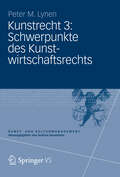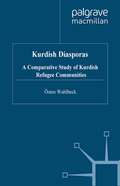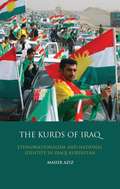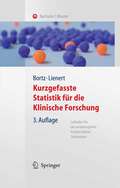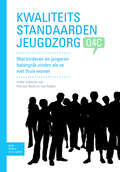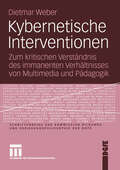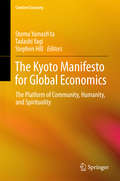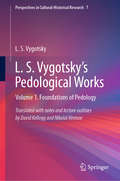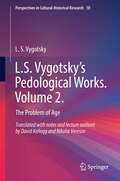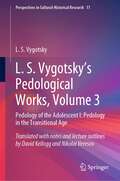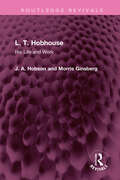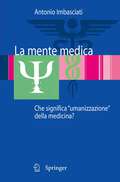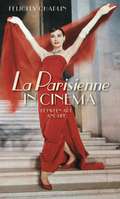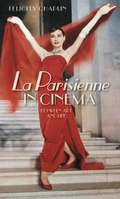- Table View
- List View
Kunstrecht 3: Schwerpunkte des Kunstwirtschaftsrechts (Kunst- und Kulturmanagement)
by Peter M. LynenIm dritten Band dieses Lehrbuchs stehen die Akteure marktbezogenen Verhaltens im Mittelpunkt. In diesem Zusammenhang wird auf einen Schwerpunkt des Kunstrechts – das Urheberrecht – besonders eingegangen. Das Kunstvertragsrecht bezieht sich indes nicht nur auf urheberrechtliche Beziehungen, sondern weist eine Fülle bedeutsamer Fallgestaltungen auf. Denen wird vertieft nachgegangen, wobei auch das Recht künstlerischer Veranstaltungen aller Sparten behandelt wird. Insgesamt geht es zunächst um die „positive und zukunftsgerichtete“ Gestaltung solcher Verträge. Sodann ist zu erläutern, was rechtlich gilt, „wenn etwas passiert“. Dabei geht es um Fragen der Verantwortung, der Haftung, des Schadensersatzes und der Versicherung von Kunst. Das Werk abschließend wird das Internationale Privatrecht in Bezug auf Kunst kurz vorgestellt.
Kunstvermittlung 2.0: Neue Medien Und Ihre Potenziale
by Andrea Hausmann and Linda FrenzelDie Neuen Medien eröffnen vielfältige Chancen für die Vermittlungsarbeit in Museen, Ausstellungshäusern und anderen Kultureinrichtungen. Vor allem ermöglichen sie eine verbesserte, direkte Einbeziehung der Besucher in die Inhalte. Die Auseinandersetzung mit Kunst wird so zu einem spannenden, partizipativen und interaktiven Erlebnis. Es ist Ziel dieses Buchs, die Potenziale der Neuen Medien für die Vermittlungsarbeit in Kunst und Kultur fundiert zu untersuchen und im Hinblick auf die Gewinnung, Entwicklung und Bindung von Besuchern praxisnah zu beleuchten.
Kurdish Diaspora Online: From Imagined Community to Managing Communities (The Palgrave Macmillan Series in International Political Communication)
by Jowan MahmodThe argument offered in this book is that new technology, as opposed to traditional media such as television, radio, and newspaper, is working against the national grain to weaken its imagined community. Online activities and communications between people and across borders suggest that digital media has strong implications for different articulations of identity and belongingness, which open new ways of thinking about the imagined community. The findings are based on transnational activities by Kurdish diaspora members across borders that have pushed them to rethink notions of belonging and identity. Through a multidisciplinary and comparative approach, and multifaceted (online-offline) methodologies, the book unveils tensions between new and old media, and how the former is not only changing social relations but also exposing existing ones. Living in two or more cultures, speaking multiple languages, and engaging in transnational practices, diaspora individuals may have created a momentum that discloses how the imagined nation is diminishing in this digital era.
Kurdish Diasporas: A Comparative Study of Kurdish Refugee Communities (Migration, Diasporas and Citizenship)
by Ö. WahlbeckIn this important theoretical contribution to the area of refugee studies based on ethnographic field work among Kurdish refugees, the author has uniquely combined empirical evidence and contemporary sociological theories of diasporas and transnationalism. The book provides essential reading for anybody looking for a comprehensive view of refugee resettlement issues and it will be of special interest to anybody concerned with the topical Kurdish question.
Kurdish Identity, Discourse, and New Media (The Palgrave Macmillan Series in International Political Communication)
by J. SheyholislamiInformed by the interdisciplinary approach of Critical Discourse Analysis (CDA) and theories of identity, nation, and media, the study investigates the ways Kurds, the world's largest stateless nation, use satellite television and Internet to construct their identities. This book examines the complex interrelationships between ethno-national identities, discourses, and new media. Not only offers the first study of discursive constructions of Kurdish identity in the new media, this book also the first CDA informed comparative study of the contents of the two media. The study pushes the boundaries of the growing area of studies of identity, nationalism and transnationalism, discourse studies, minority language, and digital media.
The Kurds of Iraq: Nationalism and Identity in Iraqi Kurdistan (Library of Modern Middle East Studies)
by Mahir A. AzizOver ninety years since their absorption into the modern Iraqi state, the Kurdish people of Iraq still remain an apparent anomaly in the modern world - a nation without a state. In 'The Kurds of Iraq', Mahir Aziz explores this incongruity, and asks the pertinent questions, who are the Kurds today? What is their relationship to the Iraqi state? How do they perceive themselves and their prospective political future? And in what way are they crucial for the stability of the Iraqi state? In the wake of the Gulf War of 1991 in the face of the Iraqi state, the Kurds endeavoured to create a de facto state and to concretise and stabilise the institutions that would enable this. 'The Kurds of Iraq' thus examines the creation, evolution and development of Kurdish nationalism despite the suppression of its political and cultural manifestations. Through extensive interviews in the field, Aziz assesses the impact of recent history on the complex process of identity formation amongst Kurdish students at three of the nation's leading universities. He provides an in depth examination of students' socio-economic backgrounds, and their thoughts on and experiences of what it means to be Kurdish in the modern Iraqi state, and the impact this has on their perception of their language, culture and religion. Aziz's invaluable and extensive field research furthermore serves as a point of departure for an investigation into the relationship between national identity and historical memory in Iraqi Kurdistan and beyond. He thus analyses wider issues of the intersection and interdependency of national, regional, ethnic, tribal and local identities. He thus constructs an intimate portrait of the Kurds of Iraq, which will provide an important insight for students and researchers of the Middle East and for those interested the important issues of nationalism and ethnic identity in the modern nation state, and the impact these issues have on the stability of Iraq itself.
Kursbestimmungen: Eine qualitative Paneluntersuchung der alltäglichen Lebensführung im ostdeutschen Transformationsprozeß (Forum - Zukunft der Gesellschaft)
by Margit WeihrichKuru Sorcery: Disease and Danger in the New Guinea Highlands
by Shirley LindenbaumPerhaps the best-documented epidemic in the history of medicine, kuru has been studied for more than fifty years by international investigators from medicine and the human sciences. This significantly revised edition of the landmark anthropological classic Kuru Sorcery brings up to date the anthropological contribution to understanding disease, the medical research that resulted in two medical Nobel Prizes, and the views of the Fore people who endured the epidemic and who still believe that sorcerers, rather than cannibalism, caused kuru. The kuru epidemic serves as a prism through which to see how Fore notions of disease causation bring into single focus their views about the body, the world of social and spiritual relations, and changes in economic and political conditions-aspects of thought and behaviour that Western medicine keeps separate.
Kuru Sorcery: Disease and Danger in the New Guinea Highlands
by Shirley LindenbaumPerhaps the best-documented epidemic in the history of medicine, kuru has been studied for more than fifty years by international investigators from medicine and the human sciences. This significantly revised edition of the landmark anthropological classic Kuru Sorcery brings up to date the anthropological contribution to understanding disease, the medical research that resulted in two medical Nobel Prizes, and the views of the Fore people who endured the epidemic and who still believe that sorcerers, rather than cannibalism, caused kuru. The kuru epidemic serves as a prism through which to see how Fore notions of disease causation bring into single focus their views about the body, the world of social and spiritual relations, and changes in economic and political conditions-aspects of thought and behaviour that Western medicine keeps separate.
Kurzgefasste Statistik für die klinische Forschung: Leitfaden für die verteilungsfreie Analyse kleiner Stichproben (Springer-Lehrbuch)
by Jürgen Bortz Gustav A. LienertDas Problem: Die kleine Stichprobe In der Forschungspraxis der Psychologie, der Medizin und der Sozialwissenschaften hat es der Anwender statistischer Verfahren überwiegend mit kleinen Stichproben zu tun. Der in der Statistik-Vorlesung gelernte t-Test oder die Varianzanalyse kann hier nicht eingesetzt werden. Die Lösung: Der „kleine“ Bortz Die „Kurzgefasste Statistik für die klinische Forschung“ setzt hier an: Es werden statistische Verfahren beschrieben, die bei kleinen Stichproben zur Hypothesenprüfung angewandt werden können. Diese verteilungsfreien Verfahren setzen nur geringe Grundkenntnisse der Statistik voraus. Anwendungsbezogene Erklärungen zur Zielsetzung und Durchführung von Untersuchungen sowie ausführliche Zahlenbeispiele machen die Anwendung der Verfahren einfach nachvollziehbar.
Kwaliteitsstandaarden Jeugdzorg Q4C: Wat kinderen en jongeren belangrijk vinden als ze niet thuis wonen.
by F. Van Beek L. RutjesKwaliteitsstandaarden Jeugdzorg Q4C is een uitzonderlijk boek! Niet omdat het gaat over de kwaliteit van de zorg voor jeugdigen die uit huis geplaatst zijn - over dat onderwerp is wel meer gepubliceerd - maar omdat de kwaliteit beschreven is vanuit het perspectief van die jongeren. Dat maakt Kwaliteitsstandaarden Jeugdzorg Q4C uniek. Q4C staat voor Quality for Children, en dit boek beschrijft de kwaliteitseisen die jeugdigen die niet thuis kunnen wonen, stellen aan de zorg die zij ontvangen.Wat vinden zij belangrijk? Wat ervaren en beleven zij nu? Wanneer zijn zij tevreden? Waar schort het volgens hen aan? De antwoorden op deze vragen zijn vastgelegd in twintig kwaliteitsstandaarden. Deze zijn maat- en richtinggevend bij het bieden van vraaggestuurde zorg.Kwaliteitsstandaarden Jeugdzorg Q4C biedt een duidelijke en toegankelijke set aan kwaliteitsstandaarden en -criteria. Ze geven respectievelijk de basisbehoeften, de standaarden, de kwaliteitsniveaus en de kwaliteitscriteria weer. Dit alles is weer vertaald naar het niveau van het primair proces, de organisatie en de kwaliteit van de medewerkers.Ook al liggen de kwaliteitscriteria vast in allerlei documenten, zoals de Wet op de jeugdzorg, concrete handvatten voor de praktijk ontbreken vaak nog. In de woorden van een 17-jarige jongen die voor dit boek geïnterviewd is: 'Criteria bedenken is niet zo moeilijk, de vraag is hoe je de jeugdzorg zover krijgt dat ze eraan gaan voldoen. De problemen liggen meer bij de uitvoering van de standaarden dan bij de standaarden op zich.' Bij die praktische uitvoering kan dit boek niet gemist worden.Ook al liggen de kwaliteitscriteria vast in allerlei documenten, zoals de Wet op de jeugdzorg, concrete handvatten voor de praktijk ontbreken vaak nog. In de woorden van een 17-jarige jongendie voor dit boek geïnterviewd is: 'Criteria bedenken is niet zo moeilijk, de vraag is hoe je de jeugdzorg zover krijgt dat ze eraan gaan voldoen. De problemen liggen meer bij de uitvoering van de standaarden dan bij de standaarden op zich.' Bij die praktische uitvoering kan dit boek niet gemist worden.
Kybernetische Interventionen: Zum kritischen Verständnis des immanenten Verhältnisses von Multimedia und Pädagogik (Schriftenreihe der Kommission Bildungs- und Erziehungsphilosophie der DGfE)
by Dietmar WeberDie pädagogische Relevanz von 'Multimedia' schlägt sich in den Begriffen des Lernens und der Medienkompetenz nieder. Das Buch entwickelt deren Bildungsbedeutung aus der kulturellen Bedeutung multimedialer Techniken und führt zu der Einsicht, dass die Verfügung über die Möglichkeiten der Technologiegestaltung unabdingbare Voraussetzung für die Entfaltung der bildungsrelevanten Qualität dieser Technologien ist.
The Kyoto Manifesto for Global Economics: The Platform of Community, Humanity, and Spirituality (Creative Economy)
by Stomu Yamash’ta Tadashi Yagi Stephen HillThis book confronts the failings of current global economics to deliver the equity, sustainability and community empowerment which humanity now needs to handle a troubled future. The volume proposes an economy built from our society, not the other way around.The Kyoto Manifesto was built, layer by layer, over a period of 4 years, based on broad-ranging international symposia held in Kyoto between 2014 and 2017, hosted by the Center for the Creative Economy, Doshisha University. Not stopping at theory and untested ideas however, the Manifesto proposes practical action that will make a difference, including in the problematic technological and ecological context of humanity’s immediate and long-term future.The book is unique and innovative for it moves adventurously across very broad territory. The Manifesto draws from world philosophic arguments, including, specifically, a critique of “liberalism”, further, exploring sociology, cultural anthropology, politics, primatology and early humanity, even quantum physics. Argument is set within mainstream post-1972 economics and political economics as well as direct practical experience working to empower disadvantaged communities through the United Nations.Most importantly, the book’s analysis is deeply informed by the practice of searching for what is “sacred”, the ultimate essence of our humanity, what we can be as a human race—empowered, fulfilled individuals, deeply sharing and caring for each other across our separate cultures and lives. Stomu Yamash’ta’s On Zen performances, set the context for the Symposia, bringing different religions and cultures together across their dividing boundaries into a coherent search for peace and harmony through sacred music. Informed by alternate cultural paradigms for economics, the book probes deeply into philosophies and practices that already exist within Eastern and Western societies, and offer lessons for our future.The result is an economics that stresses harmony with nature, and balance in social relations. It places an emphasis on community—human sharing and trust—as a platform for our future, not separate from the global economy but integrated into its very foundations. This is a book for all who care: a plan for our sustainable future built from the best of what our humanity is and can offer.
L. S. Vygotsky's Pedological Works: Volume 1. Foundations of Pedology (Perspectives in Cultural-Historical Research #7)
by L.S. VygotskyThis book provides both a lost last word and a firm first foundation: seven lectures, given in the last months in the life of the Soviet thinker, teacher, and writer L.S. Vygotsky, offer us the most comprehensive and developed form of his thoughts on the child, expressed in the most fundamental and even popular form that Vygotsky himself used with his beginner-level students. As the title of Vygotsky’s course indicates, these are foundations upon which cultural-historical researchers can rebuild the lost science of “pedology”, a holistic approach to child development based on the dynamic unity of physical and mental development. Volume One includes translations of seven of Vygotsky’s lectures that reflect his approach to pedology; the method of pedology and the “methodics” of the unit of analysis; the role of heredity and social environment in child development; and general laws of development in childhood that will help parents and teachers understand the way the child’s endocrine system, nervous system, and mind change as the child enters a culture and learns to make history.
L.S. Vygotsky’s Pedological Works. Volume 2.: The Problem of Age (Perspectives in Cultural-Historical Research #10)
by L.S. VygotskyThis book is the second volume in a series presenting new English translations of L.S. Vygotsky’s writings on the holistic science of the child he called “pedology”. It presents unique materials which reflect the development of Vygotsky’s theoretical position at the last stage of his creative evolution in 1932-1934 and contributes to the number of original Vygotsky texts available in English. It includes the problem of age and age periodization; the structure and dynamics of age, psychological characteristics of age crises and diagnostics of development in relation to age, and the zone of proximal development, which became his most widely known but least understood theoretical innovation. This book places that concept in its context and makes it fully understandable for the first time. In addition, there are lectures and notes that Vygotsky made in preparation for lectures on six critical periods: birth, one year old, three, seven, and thirteen. Vygotsky also devotes chapters to the stable periods of infancy and early childhood and two whole chapters to school age. Future volumes in this series will explore Vygotsky’s pedology of the adolescent.
L. S. Vygotsky's Pedological Works, Volume 3: Pedology of the Adolescent I: Pedology in the Transitional Age (Perspectives in Cultural-Historical Research #11)
by L. S. VygotskyThis book contains the first complete translation of the first half of the Pedology of the Adolescent by the Soviet thinker, educator, and teacher L.S. Vygotsky. It was the longest work published in his lifetime and was a correspondence course written by Vygotsky for teachers across the Soviet Union. The book is a sustained argument about the borders of pedology, the nature of the transition between childhood and adulthood, and the concrete character of the distinction between the lower psychological functions that we largely share with animals and those that are specific to fully socialized humans. After an initial methodological introduction, three kinds of maturation—general anatomical, sexual, and sociocultural—are explored. This book will be followed by a companion volume covering pedology of the transitional age as a psychological and social problem.
L. S. Vygotsky's Pedological Works, Volume 4: Pedology of the Adolescent II: Pedology of the Transitional Age as a Psychological and Social Problem (Perspectives in Cultural-Historical Research #12)
by L. S. VygotskyThis book contains a new translation of the second half of the Pedology of the Adolescent by the renowned Soviet thinker, educator and teacher L.S. Vygotsky. It was a correspondence course written by Vygotsky for teachers across the Soviet Union, and it constitutes the longest work published in his lifetime. Four chapters have never been translated before and appear here for the very first time. With this volume, Vygotsky concludes the sustained argument he commenced in Vol. 3 Pedology of the Adolescent I: Pedology in the Transitional Age, establishing the borders of pedology, the nature of the transition between childhood and adulthood, and the concrete nature of the distinction between the lower psychological functions we largely have in common with animals and those that are specific to fully social humans. In this volume Vygotsky "puts flesh on the skeleton" of his working hypothesis concerning the interests and the development of concepts in the psychology of the adolescent. He then frames concepts as a special case of developing higher psychological functions, and demonstrates the roots of that development in the social environment. Many of the problems Vygotsky broaches in these new chapters--the choice of a profession, the initiation of the adolescent into working life--are still of immediate, not to say urgent, relevance today. The volume concludes with a remarkable vision of a society "where production is organized for the producers" that still seems far ahead of its time and still ahead of our own.
L. T. Hobhouse: His Life and Work (Routledge Revivals)
by J. A. Hobson Morris GinsbergFirst published in 1931, L. T. Hobhouse is an amalgamation of the late social philosopher L. T. Hobhouse’s personal life and academic work. The first part of this volume is a brief biography by Mr. J. A. Hobson, with added impressions by personal friends and colleagues. It is followed by an account of his philosophy and sociology written by Professor Morris Ginsberg, his pupil and successor at the London School of Economics. Third section consists of some collected essays illustrative of his various capacities and interests. This book will be of interest to students of philosophy and sociology.
L. T. Hobhouse: His Life and Work (Routledge Revivals)
by J. A. Hobson Morris GinsbergFirst published in 1931, L. T. Hobhouse is an amalgamation of the late social philosopher L. T. Hobhouse’s personal life and academic work. The first part of this volume is a brief biography by Mr. J. A. Hobson, with added impressions by personal friends and colleagues. It is followed by an account of his philosophy and sociology written by Professor Morris Ginsberg, his pupil and successor at the London School of Economics. Third section consists of some collected essays illustrative of his various capacities and interests. This book will be of interest to students of philosophy and sociology.
La mente medica: Che significa "umanizzazione" della medicina?
by Antonio ImbasciatiIl paziente dei nostri servizi sanitari è una persona o un numero? Un soggetto o un oggetto? Una persona sofferente o un insieme di meccanismi da aggiustare in una catena di montaggio di tanti specialisti? A ragione si parla oggi di umanizzazione della medicina e di demedicalizzazione dei servizi. Ci sono oltre venti lauree sanitarie ognuna delle quali dovrebbe comportare una professione diversa da quella del medico, e "più umana": nel percorso formativo di queste lauree sono previste diverse discipline psicologiche e sociali. Ma l’impresa è difficile. Giustamente definite sanitarie, anziché mediche, anzi meglio "della salute", o "di aiuto", queste professioni dovrebbero essere diverse da quella medica: sono di fatto diventate altrettante "altre" professioni mediche. La "mente medica", nel collettivo delle Organizzazioni si è appropriata di queste professioni come fossero "sue". Le diverse scienze psicologiche in primis la Psicologia Clinica e la Psicosomatica, dovrebbero essere al centro della formazione, anzi di una nuova forma mentis, di questi nuovi operatori. Ma come viene applicato l’intento del legislatore nell’Università Italiana e nella cultura sanitaria? Il grande mantello della medicina, di una certa medicina, copre gli scopi che erano stati intuiti come necessari per le differenti professione della Salute. Il presente testo intende chiarire misconoscimenti e riduzionismi che paralizzano il pur auspicato mutamento della medicina e le sue articolazioni in differenti professionalità. La Psicologia Clinica si pone come chiave per leggere la mentalità collettiva che sottende l’attuale cultura sanitaria medicalizzante, che si scontra con le esigenze della persona umana, negando, oltretutto, quanto la psicosomatica oggi ci dice circa la costante modulazione psichica di tutti i processi organici, nella salute così come in tutte le malattie. L’umanizzazione della medicina non è un surplus eticamente giusto per il malato: è un indispensabile agente terapeutico. La sua mancanza è iatrogena.
La Parisienne in cinema: Between art and life
by Felicity ChaplinChic, sophisticated, seductive and enigmatic, the Parisienne possesses a je ne sais quoi that makes her difficult to define. But who or what is the Parisienne, and how is she depicted in cinema? The first book-length study on the subject combines scholarship in the fields of art history, literature and fashion to enrich our understanding of this intriguing cinematic figure, simultaneously offering new perspectives on film. Accessible and wide-ranging, it will be of immediate interest to students and researchers working in film studies, French studies and the broader humanities, as well as cinephiles and Francophiles alike.
La Parisienne in cinema: Between art and life
by Felicity ChaplinChic, sophisticated, seductive and enigmatic, the Parisienne possesses a je ne sais quoi that makes her difficult to define. But who or what is the Parisienne, and how is she depicted in cinema? The first book-length study on the subject combines scholarship in the fields of art history, literature and fashion to enrich our understanding of this intriguing cinematic figure, simultaneously offering new perspectives on film. Accessible and wide-ranging, it will be of immediate interest to students and researchers working in film studies, French studies and the broader humanities, as well as cinephiles and Francophiles alike.
La-préhension du réel
by Andre CoretLe réel est (réellement) non représentable: telle est la découverte majeure que les scientifiques et les physiciens en particulier, ont faite pour leur compte au cours du XXe siècle. Mais, le savent-ils? The real is (really) unrepresentable: this is the major discovery that scientists and physicists in particular have made on their own during the twentieth century.
La-préhension du réel
by Andre CoretLe réel est (réellement) non représentable: telle est la découverte majeure que les scientifiques et les physiciens en particulier, ont faite pour leur compte au cours du XXe siècle. Mais, le savent-ils? The real is (really) unrepresentable: this is the major discovery that scientists and physicists in particular have made on their own during the twentieth century.
La Production Du Corps
by Maurice Godelier Michel PanoffFirst published in 2004. Dans quelle mesure le corps fait-il l'identité d'un être humain ? Et pour combien de temps si quelque chose survit de lui, après sa mort, ce n'est pas tout à fait son corps ? Dans toutes les cultures, il semble que l'humanité, sous des formes diverses, ait été amenée à imaginer l'être humain comme composé de deux parties : une partie périssable et une partie qui continue d'agir bien au-delà de la mort, même si elle n'est pas immortelle. Ces deux parties ne se réduisent pas nécessairement à un corps visible et à un animal double, invisible, mais qui meurt quand l'autre meurt. Chez les Maenge de Nouville-Guinée, l'individu a deux âmes, même s'il n'a qu'un seul corps. De nombreuses sociétés pensent qu'il faut plus de deux êtres humains pour faire un être humain. Il faut que l'esprit d'un ancêtre, ou l'action d'un dieu vienne sinon animer ce corps, du moins le rendre complet, le compléter. Chaque personne naît donc, s'étant inscrite en soi, formant comme une sorte d'intimité impersonnelle, un ensemble d'idées, d'images, de valeurs, par lesquelles l'ordre ou les désordres qui s'impriment dans son corps. règne dans sa société. Seize anthropologues et historiens ont exploré ces réalités culturelles dispersées dans l'espace et le temps.
